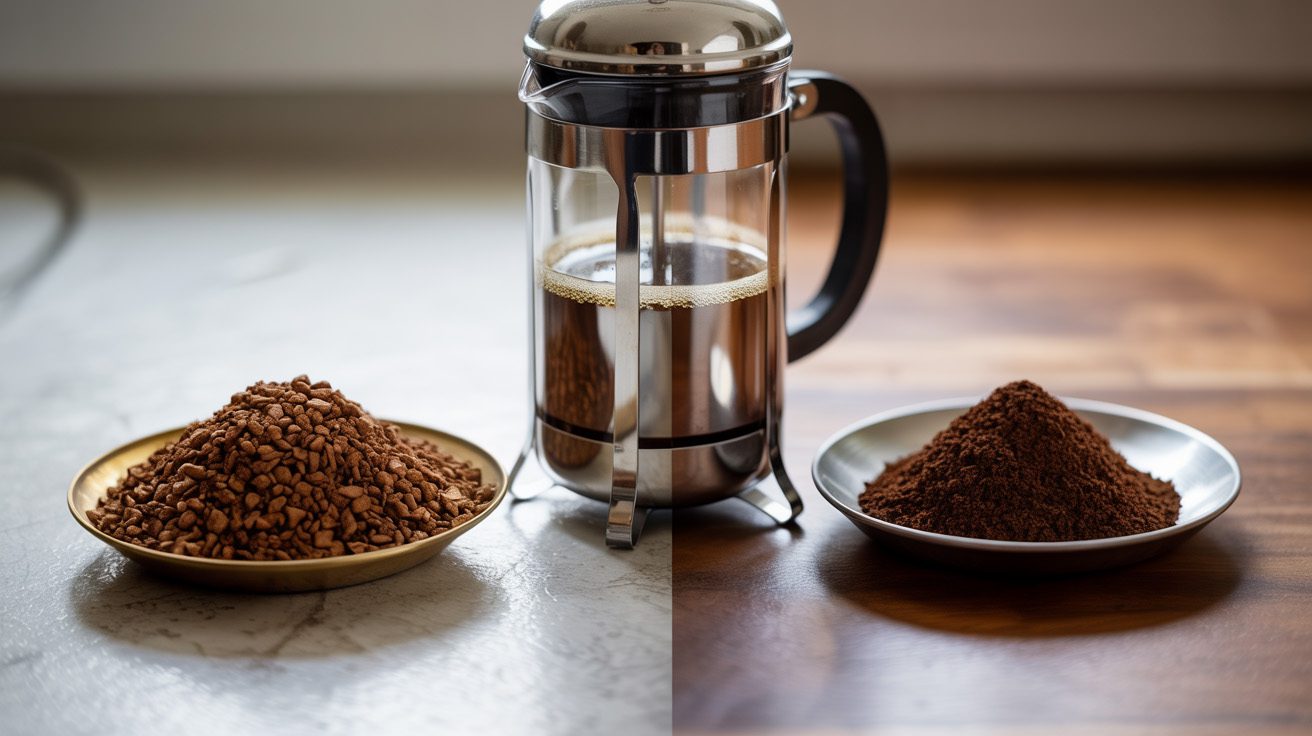Coffee Blog
Your French Press is Lying to You: The One Mistake 90% of Coffee Drinkers Make

You’ve invested in a beautiful, stainless steel French press. You seek out freshly roasted beans. You’ve even perfected your bloom time. You follow the recipe to the letter, plunge slowly, and pour a cup that looks rich and inviting. It’s good. Maybe even great.
But is it spectacular? Does it have the clarity, the sweetness, the vibrant notes of blueberry or chocolate that the bag promised? Or is it just… a good, strong cup of coffee, often with a bit of silt at the bottom and a faint bitterness that lingers?
If it’s the latter, you’re not alone. You’re part of the 90%. And the problem isn’t you, your technique, or even your beans.
The problem is your grinder.
That’s the one mistake undermining your entire French press operation. Your press is lying to you by producing a drinkable—even enjoyable—brew despite this fundamental flaw, tricking you into thinking you’ve reached the pinnacle of what it can do. But I’m here to tell you that a world of unimaginably better coffee is just one grind away.
The Lie Your French Press Tells
The French press, or cafetière, is famously forgiving. It’s why it’s a staple for coffee beginners and experts alike. Its design is simplicity itself: steep coarsely ground coffee in hot water, press down a mesh filter to separate the grounds, and pour.
This forgiveness is the lie. Because the press will make a decent cup even with mediocre grounds, we assume it’s making the best cup it can. We blame the bean, the water temperature, or the brew time for any shortcomings, never suspecting the true culprit sitting on your countertop.
That culprit is almost certainly a blade grinder.
Blade vs. Burr: The Civil War in Your Kitchen
To understand why the grinder is so important, you need to understand what we’re trying to extract from a coffee bean. Inside each bean are hundreds of compounds that contribute to flavor. The goal of brewing is to dissolve the delicious ones (sugars, acids, lipids) and leave behind the bitter, unpleasant ones (mostly tannins).
Extraction is all about surface area. Consistent extraction requires consistent surface area. This is the fundamental difference between the two types of grinders.
The Blade Grinder (The Problem): This is the whirly-blade chopper you might have. It doesn’t grind; it hacks and smashes the beans into random-sized particles with wild abandon. The result is a chaotic mix of powdery fines, large boulders, and everything in between.
-
The Fines: These tiny particles have a massive surface area. They over-extract in seconds, releasing bitter, astringent flavors that make your coffee taste harsh.
-
The Boulders: These large chunks have very little surface area. They under-extract, meaning you leave behind delicious sugars and acids, resulting in a weak, sour cup.
Using a blade grinder forces you to brew a paradox: a cup that is simultaneously bitter and weak. You have to find a brew time that is a miserable compromise between the two extremes.
The Burr Grinder (The Solution): A burr grinder features two precisely engineered surfaces (ceramic or metal) that crush the beans at a fixed distance. This allows you to choose a specific size and, crucially, produces a consistent grind where nearly every particle is the same size.
-
The Result: With uniform particles, everything extracts at the same rate. You can choose a brew time that perfectly extracts all the good flavors without dragging out the bad ones. The difference is not subtle; it is a seismic shift in your coffee’s taste.
The “One Mistake” in Action: A Taste Test
I was a skeptic, too. To prove it to myself, I conducted a blind taste test.
-
Coffee A: Ground with my high-end burr grinder set to a coarse setting.
-
Coffee B: Ground with a standard blade grinder, pulsing until it looked roughly the same coarseness.
I brewed both in identical French presses with the same water, same coffee-to-water ratio, and same four-minute steep time.
The results were staggering:
-
Coffee A (Burr Ground): The aroma was complex and fruity. The flavor was clean, sweet, and nuanced. I could clearly taste the notes described on the bag—a bright citrus acidity and a smooth chocolate finish. The body was full and silky without being muddy.
-
Coffee B (Blade Ground): The aroma was flat and smoky. The first sip was immediately dominated by a harsh, bitter punch. Underneath that was a vague, weak coffee flavor. It was monolithic—one note of generic “coffee” bitterness that drowned out any nuance. The aftertaste was abrasive and left a gritty feel on my tongue.
Coffee A was vibrant and alive. Coffee B was dull and broken. The only variable was the grind consistency.
Beyond the Grinder: Honing Your French Press Technique
Upgrading to a burr grinder is 90% of the battle, but now that you’re using a proper tool, let’s refine your technique to absolute perfection.
1. The Grind Size: Coarse, But Not Too Coarse.
The classic advice is “coarse sea salt.” That’s a good starting point. But with a consistent burr grind, you can experiment. Try a slightly finer grind (closer to a coarse sand) and reduce your steep time by 30 seconds. This can increase extraction and bring out more sweetness without the risk of over-extraction and bitterness, because you’ve eliminated the fines that cause it.
2. The James Hoffmann Method: A Cleaner Revelation.
World champion barista James Hoffmann’s French press method is a game-changer for achieving a clean, silt-free cup. Here’s the condensed version:
-
Add your coffee and water (at 200°F / 93°C) as usual.
-
After 4 minutes, break the crust on top, stir, and scoop off any floating grounds and foam.
-
Wait another 5-10 minutes for all the fine particles to settle to the very bottom.
-
Slowly press the filter down only until it sits just above the coffee bed. Do not press all the way to the bottom.
-
Pour gently and enjoy a cup that is strikingly clean and full-bodied.
3. The Ratio and Water.
Don’t neglect your other variables. Use a scale! A good starting ratio is 1:15 — 60 grams of coffee for 900 grams (ml) of water. And always use good water. If your tap water tastes bad, your coffee will too. A simple filter pitcher can make a world of difference.
The Truth Will Set Your Coffee Free
Your French press isn’t a simple rustic brewer; it’s a powerful extraction device capable of producing some of the most full-bodied and flavorful coffee you can make at home. It has been silently waiting for you to give it the one thing it needs to shine: a consistent grind.
Ditching the blade grinder for a burr grinder isn’t just a minor upgrade—it’s the fundamental step that separates good coffee from extraordinary coffee. It is the difference between hearing a symphony played on a child’s recorder and hearing it performed by a full orchestra.
Stop blaming the bean, the brew, or the press. The lie ends now. Invest in a burr grinder, and for the first time, hear the truth your French press has been trying to tell you all along.



 Bee Mugs
Bee Mugs Bird Mugs
Bird Mugs Bunny Mugs
Bunny Mugs Cat Mugs
Cat Mugs Goat Mugs
Goat Mugs Horse Mugs
Horse Mugs Lion Mugs
Lion Mugs Monkey Mugs
Monkey Mugs Moose Mugs
Moose Mugs Owl Mugs
Owl Mugs Sheep Mugs
Sheep Mugs Snail Mugs
Snail Mugs Turtle Mugs
Turtle Mugs Unicorn Mugs
Unicorn Mugs
 Engagement Mugs
Engagement Mugs Retirement Mugs
Retirement Mugs St Patrick’s Day Mugs
St Patrick’s Day Mugs Thank You Mugs
Thank You Mugs
 Boss Mugs
Boss Mugs Christmas Mugs
Christmas Mugs Colleague Mugs
Colleague Mugs Dad Mugs
Dad Mugs Grandad Mugs
Grandad Mugs Grandma Mugs
Grandma Mugs Husband Mugs
Husband Mugs Lawyer Mugs
Lawyer Mugs Nurse Mugs
Nurse Mugs Sarcastic Mugs
Sarcastic Mugs Uncle Mugs
Uncle Mugs Wife Mugs
Wife Mugs
 Fourth of July Mugs
Fourth of July Mugs Halloween Mugs
Halloween Mugs Thanksgiving Mugs
Thanksgiving Mugs Valentines Day Mugs
Valentines Day Mugs
 Amsterdam Mugs
Amsterdam Mugs Barcelona Mugs
Barcelona Mugs Berlin Mugs
Berlin Mugs Chicago Mugs
Chicago Mugs Dubai Mugs
Dubai Mugs London Mugs
London Mugs Paris Mugs
Paris Mugs Rome Mugs
Rome Mugs Sydney Mugs
Sydney Mugs Tokyo Mugs
Tokyo Mugs Toronto Mugs
Toronto Mugs
 Aunt Mugs
Aunt Mugs Boss Mugs
Boss Mugs Boyfriend Mugs
Boyfriend Mugs Co-Worker Mugs
Co-Worker Mugs Couples Mugs
Couples Mugs Gamer Mugs
Gamer Mugs Girlfriend Mugs
Girlfriend Mugs Nanny Mugs
Nanny Mugs Sister Mugs
Sister Mugs Teachers Mug
Teachers Mug
 Baseball Mugs
Baseball Mugs Fishing Mugs
Fishing Mugs Football Mugs
Football Mugs Golf Mugs
Golf Mugs Rugby Mugs
Rugby Mugs Soccer Mugs
Soccer Mugs Tennis Mugs
Tennis Mugs
 Best Man Mugs
Best Man Mugs Bridesmaids Mugs
Bridesmaids Mugs Father of the Bride Mugs
Father of the Bride Mugs Groomsmen Mugs
Groomsmen Mugs Matron of Honor Mugs
Matron of Honor Mugs
 Inspirational Mugs
Inspirational Mugs Offensive Mugs
Offensive Mugs Sexy Mugs
Sexy Mugs